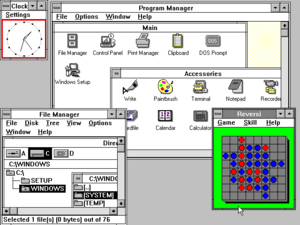Multimedia Extensions
| A version of the Microsoft Windows operating system | |
 |
|

Screenshot of Windows 3.0
|
|
| Developer | Microsoft |
|---|---|
| Source model | Closed source |
| Released to manufacturing |
May 22, 1990 |
| Latest release | 3.00a with Multimedia Extensions / October 20, 1991 |
| License | Commercial software |
| Preceded by | Windows 2.1x (1988) |
| Succeeded by | Windows 3.1x (1992) |
| Support status | |
| Unsupported as of December 31, 2001 | |
Windows 3.0, a graphical environment, is the third major release of Microsoft Windows, and was released on May 22, 1990. It became the first widely successful version of Windows and a rival to Apple Macintosh and the Commodore Amiga on the graphical user interface (GUI) front. It was followed by Windows 3.1.
Windows 3.0 originated in 1989 when David Weise and Murray Sargent independently decided to develop a protected mode Windows as an experiment. They cobbled together a rough prototype and presented it to company executives, who were impressed enough to approve it as an official project.
Windows 3.0 succeeded Windows 2.1x and included a significantly revamped user interface as well as technical improvements to make better use of the memory management capabilities of Intel's 80286 and 80386 processors. Text mode programs written for MS-DOS can be run within a window — a feature previously available in a more limited form with Windows/386 2.1 — making the system usable as a crude multitasking base for legacy programs. However, this was of limited use for the home market, where most games and entertainment programs continued to require raw DOS access.
The MS-DOS Executive file manager/program launcher was replaced with the icon-based Program Manager and the list-based File Manager, splitting files and programs. The Control Panel, previously available as a standard-looking applet, was re-modeled after the one in the classic Mac OS. It centralized system settings, including control over the color scheme of the interface.
...
Wikipedia
